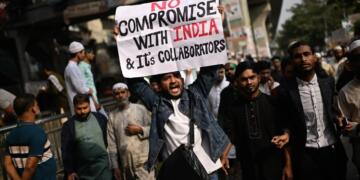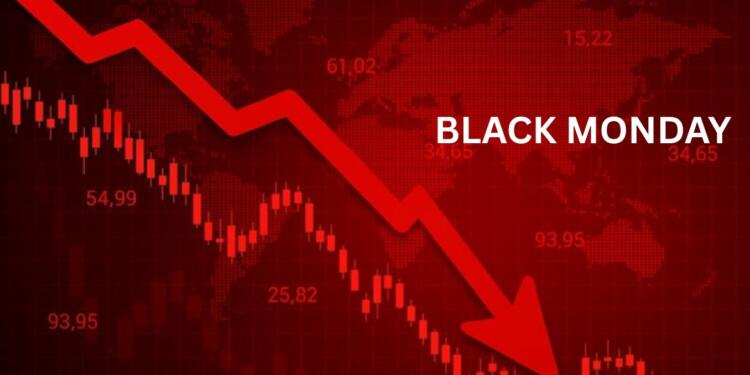Indian benchmark indexes plummeted on Monday, following a spate of global market panic. Both the Sensex and Nifty crashed more than 5% in initial trading, replicating sharp falls elsewhere in Asia, with Japan’s Nikkei falling almost 8% after a record selloff on Wall Street last Friday.
Why Is ‘Black Monday’ Trending?
The phrase ‘Black Monday’ was trending worldwide as markets plummeted, only days after American television personality and market commentator Jim Cramer warned of the possibility of a market crash similar to the notorious Black Monday of 1987. He had forecast a market “bloodbath” possible on April 7 as a result of heightened US-China trade tensions.
“We won’t have to wait too long to find out — we’ll know by Monday,” Cramer had said.
Experts Warn of Global Recession
The widespread selloff reinforced fears of a looming global recession. Most economists are convinced that the escalating US-China trade war has the potential to devastate the global economy. If the recession gets a grip, markets might still have further to go down.
Flashback: Black Monday, 1987
On October 19, 1987, markets around the world collapsed in a historic crash. The Dow Jones Industrial Average fell 22.6% in one day — its largest one-day percentage decline in history. The S&P 500 fell even harder, losing 30%. The mayhem spread across the globe, and markets took weeks to bounce back.
What caused the Black Friday crash?
The cause of the massive stock market drop cannot be attributed to any single news event since no major news event was released the weekend preceding the crash. However it is ascertained that several events culminated to create an atmosphere of panic among investors. Some reasons for the crash:
1. A strong bull market overdue for a correction: One of the main factors that drove the Black Monday crash was a strong bull market that was overdue for a major correction in prices since 1982.
2. Program Trading: Computerized trading, which was still not the dominant force it is today, was increasingly making its presence felt at several Wall Street firms. The stock market crash of 1987 revealed the role of financial and technological innovation in automatic trading, also called program trading, human decision-making is taken out of the equation, and buy or sell orders are generated automatically based on the price levels of benchmark indexes or specific stocks.
3. Portfolio Insurance: Portfolio insurance is a program trading strategy that seems to be one of the key factors at the center of Black Monday. The strategy is aimed to hedge a portfolio of stocks against market risk by short-selling stock index futures, thus limiting the potential losses if stocks decline in price, without having to sell off those stocks. The computer programs began liquidating stocks as certain loss targets were hit, pushing prices lower. This led to a domino effect as the falling markets triggered more stop-loss orders, while bids stopped.
4. Triple Witching: October 16, the Friday before the crash, experienced the simultaneous expiration of stock options, stock index futures, and stock index options contracts, a phenomenon known as triple witching. This resulted in extremely high volatility on the last hour of Friday trading, with large sell-offs in the after-hours markets.
5. Mass Panic: The international political climate also made investors jittery. The role of media as an amplifying factor for these developments has also come in for criticism. The mass panic caused the crash to escalate. Once the decline started, people continued to sell.
Massive Wealth Wipeout in India
The Indian market crash erased more than ₹19.44 lakh crore of investor wealth in one day. The market capitalization of BSE-listed companies fell to ₹383.95 lakh crore from ₹403.39 lakh crore on Friday, April 4.
Since April 2 — dubbed ‘Liberation Day’ after US President Donald Trump announced reciprocal tariffs — investor wealth has eroded by nearly ₹29 lakh crore.
Rupee Weakens
Amid the market turmoil, the Indian rupee also took a hit, slipping 19 paise to trade at 85.63 against the US dollar.
Index Performance Today
Sensex: Down 3,939.68 points (-5.22%) to 71,425.01
- Nifty: Down 1,160.8 points (-5.06%) to 21,743.65
- Asian Markets Plunge
The market carnage wasn’t limited to India: - Japan’s Nikkei 225: Down nearly 8% after opening, later recovering slightly to -6% at 31,758.28
- Hong Kong’s Hang Seng: Crashed 9.4% to 20,703.30
- Shanghai Composite: Fell 6.2% to 3,134.98
- South Korea’s Kospi: Dropped 4.1% to 2,363.82
- Australia’s ASX 200: Lost 3.8% to 7,377.70, after initially dropping over 6%
Outlook
As the trade war escalates and investor sentiment turns bearish, market volatility is expected to remain high. Analysts warn that the worst may not be over yet, with recession fears and geopolitical tensions likely to dominate the economic landscape in the coming weeks.































